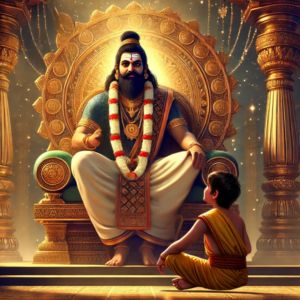Beyond Dharma and Adharma

The 14th mantra of the dvitiya valli of the first chapter of Kathopanishad -
अन्यत्र धर्मादन्यत्राधर्मादन्यत्रास्मात्कृताकृतात् । अन्यत्र भूताच्च भव्याच्च यत्तत्पश्यसि तद्वद ॥
Nachiketas is asking Yamaraja -
'Beyond dharma, beyond adharma,
Beyond action and inaction.
Beyond past and future,
Speak only what you see.'
The Kathopanishad, a profound Vedic scripture, unfolds as a dialogue between the young seeker Nachiketas and Yama, the god of death. At its heart lies a timeless inquiry into the nature of the Self. The 14th mantra of the Dvitiya Valli captures Nachiketas’s resolve to transcend worldly dualities, seeking not transient truths but the immortal Aksharatma (eternal Self).
Context: The Encounter Between Nachiketas and Yama
Nachiketas’s journey begins with a bold confrontation: rejecting Yama’s initial offers of material wealth, he demands knowledge of the soul beyond life and death. Yama, testing his resolve, dismisses him as 'too young,' but Nachiketas’s persistence reveals his readiness. His question—'What lies beyond Dharma, Adharma, past, and future?'—reflects a seeker prepared to pierce through illusion (Maya) and grasp the absolute.
Key Concepts: Unraveling the Upanishadic Vision
- Dharma and Adharma: The Dance of Truth and Ignorance
- Dharma signifies alignment with cosmic truth, eternal and unchanging. Adharma, its shadow, stems from ignorance. The Upanishad illustrates this through Soma (sacred elixir) and Sura (alcohol): one elevates consciousness; the other obscures it.
- Relativity of Dharma: A Brahmin’s Dharma to respond with peace differs from a Kshatriya’s duty to uphold justice. Context defines virtue, yet the soul remains untouched by these roles.
- The Soul: Witness Beyond Dualities
The Atma is neither virtuous nor sinful; it is the eternal experiencer. Like a mirror, it reflects actions (karma) but remains untainted. The Bhagavad Gita echoes this, distinguishing Dharma-buddhi (wisdom) from Adharma-buddhi (delusion). Liberation arises when one realizes the Self transcends all labels. - Transcending Karma and Time
- Sukarma (righteous acts) and Kukarma (harmful deeds) bind the Karmatma (soul entangled in rebirth). Yet, the Aksharatma is beyond these, akin to a movie screen unaffected by the drama projected onto it.
- Time (Bhuta—past, Bhavya—future) governs the material world, but the soul exists anyatra (beyond), in the timeless realm of Brahman.
- Cosmology: The Three Worlds and the Hierarchy of Reality
The universe is structured into three realms: - Prithvi (Earth), ruled by Agni (action),
- Antariksha (Atmosphere), governed by Vayu (vital energy),
- Svarga (Heaven), presided over by Indra (knowledge).
These symbolize the interplay of body, mind, and spirit. The Aksharatma, however, transcends even these, residing as the 'Great Unmanifest.'
Mechanism of Rebirth and Liberation
- Samskaras (mental impressions) from Dharma/Adharma dictate rebirth. A selfless act plants seeds of joy; greed breeds suffering.
- Liberation (moksha) comes through Jnana (self-knowledge), dissolving samskaras. Like wiping dust from a mirror, it reveals the soul’s innate purity.
Nachiketas’s Threefold Inquiry and Yama’s Revelation
Nachiketas’s quest encompasses three dimensions:
- Paramatma (supreme Self),
- Gudhotma (soul veiled by ignorance),
- Karmatma (soul bound by karma).
Conclusion: The Journey from Ignorance to Immortality
Nachiketas’s dialogue with Yama is a metaphor for every seeker’s path. By rejecting ephemeral rewards and insisting on the eternal, he embodies the Upanishadic ideal: discern the immortal Self amidst life’s dualities. In a world obsessed with Dharma and Adharma, the Kathopanishad reminds us that liberation lies not in action or inaction but in realizing we are the screen - not the movie.
'As the soul traverses bodies, the wise grieve neither for the living nor the dead. For the Self is beyond time, and in its light, all dualities dissolve.'

English
Kathopanishad
Click on any topic to open
- 27 Beyond Dharma and Adharma
- 26 Liberation is Right Here
- 25 The Path to the Supreme Realm
- 24 Attaining the Permanent through the Impermanent
- 23 Genuine Curiosity vs. Petty Arguments
- 22 Maharshis Are Human Too: Why Their Wisdom Matters
- 21 Why Self-Realization Is So Elusive
- 20 Understanding Gatis in the Kaṭhopaniṣhad
- 19 The foolish blind followers
- 18 Objects are Neutral: Perspective Decides Spiritual or Worldly Route
- 17 The Two Paths: Worldly Joy vs. Spiritual Joy in Kathopanishad
- 16 Long-Term Thinking: Kathopanishad’s Teachings on Beating Cognitive Biases
- 15 Shreya vs. Preya: Choosing Long-term Well-being Over Immediate Gratification
- 14 Balancing Benefit and Enjoyment
- 13 What to Ask for if You Meet God
- 12 Nachiketas Responds To The Offer Of Yamaraja
- 11 Yamaraja Tries To Dissuade Nachiketas
- 10 Third Boon Of Nachiketas
- 9 How to attain absolute peace?
- 8 Extra Boon From Yamaraja To Nachiketas
- 7 Yamaraja Teaches Nachiketas About Swargya Agni
- 6 The Second Boon Of Nachiketas
- 5 The First Boon Of Nachiketas
- 4 Which Comes First, Night Or Day?
- 3 Why The Guest Should Be Treated Like God
- 2 Why Did Nachiketas Faint?
- 1 Why Was Nachiketas Baffled?
7
30
Astrology
Atharva Sheersha
Bhagavad Gita
Bhagavatam
Bharat Matha
Devi
Devi Mahatmyam
Ganapathy
Glory of Venkatesha
Hanuman
Kathopanishad
Mahabharatam
Mantra Shastra
Mystique
Practical Wisdom
Purana Stories
Radhe Radhe
Ramayana
Rare Topics
Rituals
Rudram Explained
Sages and Saints
Shiva
Spiritual books
Sri Suktam
Story of Sri Yantra
Temples
Vedas
Vishnu Sahasranama
Yoga Vasishta